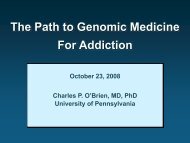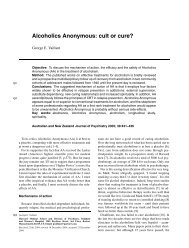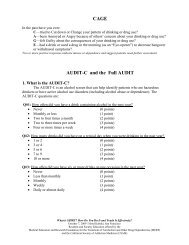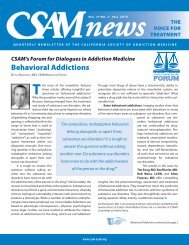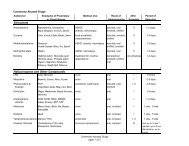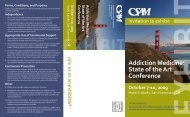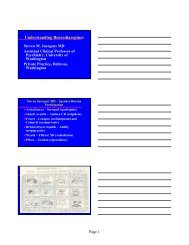SAN FRANCISCOMEDICINE - California Society of Addiction ...
SAN FRANCISCOMEDICINE - California Society of Addiction ...
SAN FRANCISCOMEDICINE - California Society of Addiction ...
You also want an ePaper? Increase the reach of your titles
YUMPU automatically turns print PDFs into web optimized ePapers that Google loves.
Continued from the previous page . . .<br />
other stimulants such as guarana to alcohol<br />
products, Big Alcohol created another<br />
new product: alcoholic energy drinks<br />
(AEDs). With names such as Four Loko,<br />
JOOSE, Liquid Charge, Max Vibe, Torque,<br />
Hard Wired, Evil Eye, Vicious Vodka,<br />
Slingshot Party Gel, and 3 A.M. Vodka,<br />
AEDs communicate a clear message to<br />
youth: Drink caffeine plus alcohol, stay<br />
awake, and drink longer/more. Recent<br />
research has found that a quarter <strong>of</strong> college<br />
student drinkers mix energy drinks<br />
with alcohol, and that students who do<br />
so are at higher risk <strong>of</strong> alcohol-related<br />
harm, including physical injuries, injuries<br />
requiring medical treatment, being the<br />
victim or perpetrator <strong>of</strong> sexual violence,<br />
and riding with an intoxicated driver<br />
(O’Brien 2008).<br />
Additional research has found that<br />
youth drinkers ages fourteen to twenty<br />
who mixed alcohol with energy drinks did<br />
so in order to hide the flavor <strong>of</strong> alcohol,<br />
drink more, not look as drunk, and stay<br />
awake longer (Song 2008). These youth<br />
were at higher risk for heavy drinking and<br />
alcohol-related harm, such as violence<br />
and driving while intoxicated, than youth<br />
who drank alcohol only (Song 2008).<br />
Despite the serious health risks and<br />
problems posed by AEDs, producers continue<br />
to target young people directly with<br />
both the products and their ad campaigns.<br />
AED producers follow the alcopops model<br />
with sugary-sweet flavors such as Four<br />
Loko’s fruit punch, blue raspberry, orange,<br />
watermelon, and grape. The added<br />
flavors easily mask the high alcohol levels<br />
<strong>of</strong> AEDs, many <strong>of</strong> which contain as much<br />
as 12% alcohol. The volume <strong>of</strong> AEDs is<br />
nearly twice as much as noncaffeinated<br />
alcoholic beverages (23.5 or 24 ounces<br />
versus a 12- or 16-ounce bottle <strong>of</strong> beer),<br />
thus putting the equivalent <strong>of</strong> four or five<br />
standard alcoholic drinks into one can.<br />
AED cans and bottles are also brightly<br />
colored and look just like energy drinks<br />
that don’t contain alcohol.<br />
AED produces inexpensive social media<br />
to develop loyal youth drinkers: social<br />
networks including Facebook, Twitter,<br />
YouTube, and MySpace; “consumer educators”<br />
(young, beautiful women giving<br />
away free product-related merchandise<br />
or free samples <strong>of</strong> the product at bars,<br />
sponsored parties, or on campus); contests<br />
with big prizes such as trips, sports<br />
or music equipment, or cash; and branded<br />
merchandise such as t-shirts, caps, and<br />
jackets. Social networks list hundreds <strong>of</strong><br />
posts that mix product promotion with<br />
bragging about harmful consequences.<br />
One Four Loko fan encouraged others to<br />
“share the love <strong>of</strong> four loko and spread the<br />
word . . . AND GET DRUNK” (Four Loko<br />
Page 2010). A JOOSE user wrote, “Just discovered<br />
joose . . . amazing, our vomiting<br />
and breaking <strong>of</strong> furniture rates at parties<br />
have skyrocketed” (JOOSE Page 2010).<br />
Over the last two years, state and federal<br />
<strong>of</strong>ficials have challenged producers <strong>of</strong><br />
AEDs about the safety <strong>of</strong> their products.<br />
As a result <strong>of</strong> investigations by state attorneys<br />
general, Anheuser-Busch InBev and<br />
MillerCoors agreed to remove stimulants<br />
from their respective caffeinated alcohol<br />
products. In November 2009, the FDA<br />
called for nearly thirty manufacturers <strong>of</strong><br />
AEDs to provide scientific evidence that<br />
adding caffeine or other stimulants to<br />
alcoholic beverages is GRAS, or generally<br />
recognized as safe. Meanwhile <strong>California</strong>,<br />
Washington, and New York introduced<br />
legislation in early 2010 to ban alcoholic<br />
energy drinks from being produced, distributed,<br />
or sold in those states.<br />
What We Can Do<br />
In order to stop Big Alcohol from<br />
harming youth in our communities, we<br />
need three major policy changes: Increase<br />
the price <strong>of</strong> alcohol, stop youth-oriented<br />
alcoholic beverages, and restrict alcohol<br />
advertising. These are some <strong>of</strong> the<br />
most cost-effective policies available to<br />
affect significant reductions in alcohol<br />
consumption and incidence <strong>of</strong> alcoholrelated<br />
harm (Anderson, Chisholm et al<br />
2009). Big Alcohol spends large amounts<br />
<strong>of</strong> money to influence policy makers, however.<br />
In 2009, the alcohol industry spent<br />
more than $1.5 million to lobby <strong>California</strong><br />
legislators. The top lobbyist clients in this<br />
list included Diageo ($220,697), Anheuser-Busch<br />
InBev ($166,068), MillerCoors<br />
($165,000), Wine and Spirits Wholesalers<br />
<strong>of</strong> <strong>California</strong> ($150,000), and the Wine<br />
Institute ($130,500) (<strong>California</strong> Secretary<br />
<strong>of</strong> State 2010).<br />
Physicians play an important role in<br />
supporting evidence-based policies and<br />
illuminating the harm Big Alcohol causes,<br />
from providing testimony at legislative<br />
hearings to sharing their expertise on<br />
alcohol-related public health issues with<br />
the press. Mary Claire O’Brien, a physician<br />
researcher at Wake Forest University, is<br />
an excellent example <strong>of</strong> such advocacy:<br />
She has published and presented research<br />
regarding the increased negative consequences,<br />
excessive drinking behaviors,<br />
and other risks associated with youth<br />
consumption <strong>of</strong> alcohol mixed with energy<br />
drinks. O’Brien has discussed the<br />
issues and available research extensively<br />
with national and local media outlets. She<br />
has also communicated with and made<br />
in-depth reviews <strong>of</strong> the literature on<br />
this topic available to the Food and Drug<br />
Administration and groups <strong>of</strong> attorneys<br />
general (Arria, O’Brien et al 2008).<br />
This kind <strong>of</strong> physician leadership<br />
in the public health arena is crucial in<br />
the fight against Big Alcohol and its<br />
harmful products. Together, physicians,<br />
researchers, advocates, and youth can<br />
stand against alcohol-related harm. The<br />
future <strong>of</strong> our youth and their communities<br />
depends on it.<br />
Sarah Mart is research and policy<br />
manager at Marin Institute, an alcoholindustry<br />
watchdog (http://www.marininstitute.org).<br />
Her recent research includes<br />
alcohol promotion on Facebook and Big<br />
Alcohol’s political contributions and lobbying<br />
to influence public health legislation.<br />
A full list <strong>of</strong> references is available<br />
online at www.sfms.org.<br />
San Francisco Influenza and<br />
Infectious Disease Forum 2010<br />
Pertussis, Measles and Flu…What’s a<br />
Clinician to Do Learn about the new ways<br />
vaccine-preventable diseases are affecting<br />
our community. Thursday, July 29, from<br />
9:00 a.m. to 12:00 p.m. at Pier 1, San Francisco.<br />
Breakfast and Free CEUs provided.<br />
RSVP to lisa.hedden@sfdph.org or check<br />
http://sfcdcp.org/izs.html for updates.<br />
32 San Francisco Medicine June 2010 www.sfms.org




